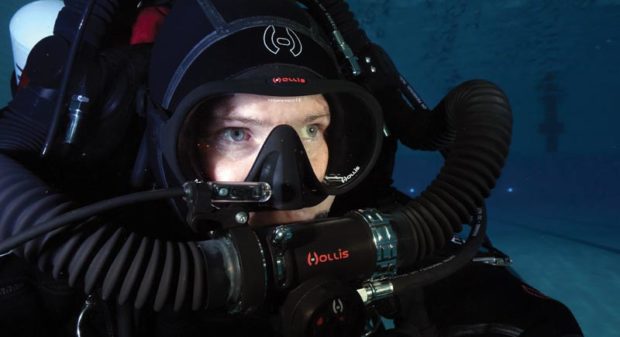Mixed Team Diving
How open circuit divers should plan to dive with their rebreather buddies
Text by Jill Heinerth

Today it is common to jump on a dive boat and find it loaded with various equipment, including open circuit scuba gear, closed-circuit rebreathers, scooters, stage bottles, and bailout tanks. If you lack technical diving experience or training on rebreathers, it can feel a bit intimidating; even more overwhelming if you are asked to team up with someone diving unfamiliar kit.
When closed-circuit rebreathers (CCR) divers and open circuit (OC) divers buddy up, they are referred to as a “mixed team”. If you are a CCR diver, you should recognize that an OC diver may feel shy about asking how dive procedures may differ. It is therefore crucial for the CCR diver to step up and offer guidance on issues such as gas management and emergency protocols before entering the water. If you are an OC diver, you need to know some basics to ensure that you are diving safely and can assist your buddy if something goes wrong.
Over 90% of rebreather incidents and accidents can be prevented by using strict surface safety protocols. That means if you are paying attention you can be a partner in accident prevention even before jumping in the water.
Pre-dive
A CCR diver should be using a pre-dive checklist to prepare his/her equipment. It is essential for the OC diver to know that a checklist has been completed and that the rebreather equipment is fully functional. It is not okay to jump in the water with two out of three sensors operational. It is unadvisable to dive with a unit that has failed any of its pre-dive checks. Statistics show that many rebreather accidents occurred after the diver entered the water with a known component failure. Be prepared to skip your dive if your closed-circuit buddy does not show the discipline that is required to comply with widely accepted protocols.
Orientation
- Have a close look at your buddy’s rebreather on the boat and learn about these key points:
- How is the rebreather donned?
- How can it be removed? Is it equipped with quick releases?
- How is the wing inflated? Is the wing gas supply served by an onboard cylinder or a bailout tank? If the gas supply is from the onboard diluent tank, then learn how this small volume can be quickly exhausted during a rescue. Determine whether you can orally inflate your buddy’s wing. In some cases, the inflator may be buried deep beneath a counter lung and may be difficult to find in an emergency.
- Ask the CCR diver how you can recognize developing problems. Learn about lights, alarms, and other safety systems. Discuss various warning lights, and audio and vibrating devices, especially those that indicate life-threatening oxygen levels or other reasons to bail to open circuit.
- Learn how and when it might be necessary to close the rebreather breathing loop and why preventing a loop flood is critical for buoyancy.
- Practice sharing gas. Will you be breathing from a long hose on a bailout tank? Where is it located and what gas will be made available to you? Has it been analyzed to your satisfaction?
Gas planning
- Use your air consumption rate to determine whether your rebreather partner is carrying appropriate volume to ensure your safe ascent in the event of a catastrophic air supply emergency.
- A rebreather diver may not anticipate the amount of decompression that the OC diver will incur. The OC diver may need to carry additional tanks of different mixes for their deco. Ensure you plan properly.
- Discuss how to deal with differing range capabilities of OC versus CC. Is your rebreather partner willing to end their dive when you need to turn around? Will they stay with you while you complete a lengthier decompression?
Complete a safety drill
- When you first descend, plan on delaying the descent long enough to complete a bubble check on the rebreather diver. You should not see any escaping bubbles from a CCR diver. However, some Semi-Closed Rebreathers may vent bubbles, so ask your rebreather partner what to look for during normal operation.
- Practice a gas sharing drill.
Safe diving
When you plan any dive, you should ask yourself if you are capable of self-rescue and are willing and able to rescue your partner in the event of an emergency. The goal of a pre-dive orientation for an OC diver is not to teach you how to be a rebreather diver, only to offer enough familiarity so that you can share gas, identify developing issues, and handle emergencies that may occur. If both divers have a frank conversation about risk and gas planning, then a safe and relaxed dive should follow.
Leave a Comment







